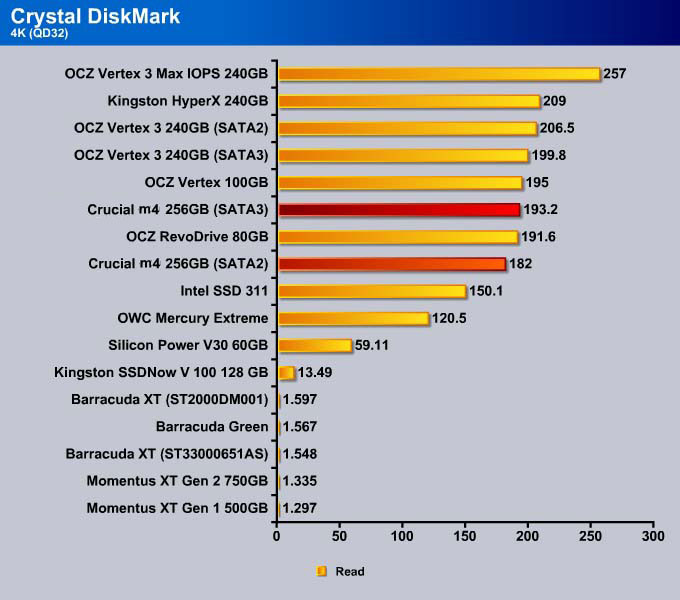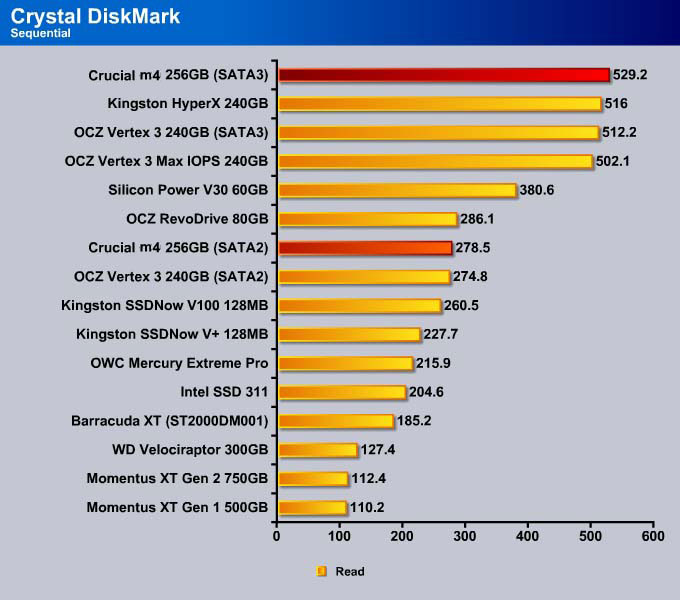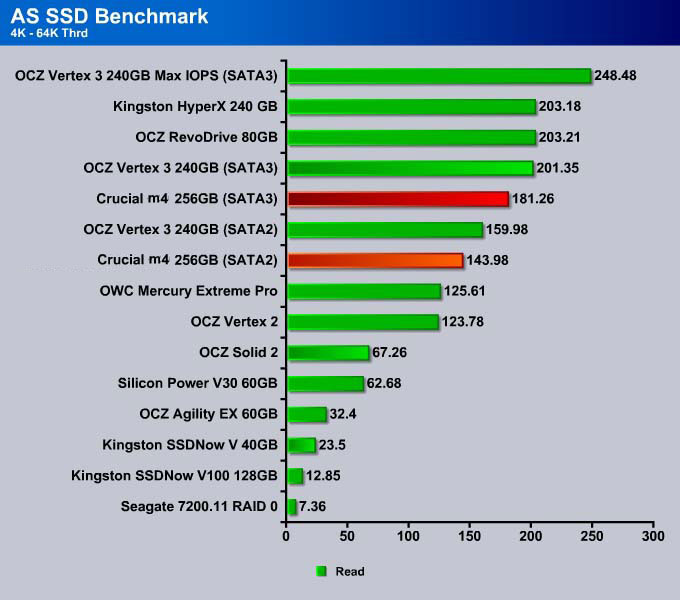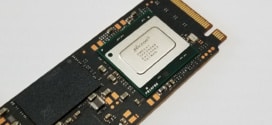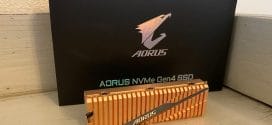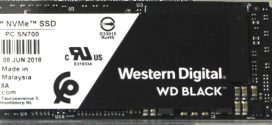Crucial’s latest m4 SSD is packed with the same controller as the first 6Gbps SSD. We put it against OCZ Vertex 3 (SandForce 2281) to see if it can the drive for you in this holiday.
Introduction
2011 was a very good year for SSDs. This year, every single new SSD released supported the SATA 6Gbps interface that finally puts the 6Gbps SATA connectors on our motherboard to full use. Unlike mechanical drives (which cannot saturate the bandwidth), SSDs are able to put the SATA III ports into great use offering exceptional performance.
This year, three big SSD controllers dominated the landscape: the Marvell 88SS9174, SandForce SF-2000, and Indilinx Everest. Crucial was the first company to bring us a 6Gbps-compatible SSD: the C300 featuring the Marvell 9174 controller. Then at the beginning of 2011, the SandForce brought us their SF-2200 controller to the market. While the OCZ Vertex 3 was the first drive with such controller, various vendors, such as Silicon Image, Patriot, Corsair, and Kingston quickly followed the footstep and launched their own drives. Then, a few weeks ago, OCZ brought the Octane featuring the latest Indilinx Everest controller.
Being the first with 6 Gbps controller, Crucial/Micron did not launch a new lineup this year, instead choosing to fine-tune the existing SATA III line, resulting in the newest iteration called the m4/C400. The main focus on the m4 drive is improving on the sequential read and write over the C300.
A quick note, Micron and Crucial are the same company except that Micron focuses on the chip and OEM brand while the Crucial is the consumer memory and storage brand. The m4 and the C400 are essentially the same drive except that the drive sold by Crucial will be labeled m4 while the drives sold by Micron will be branded C400.
Crucial SSD m4/C400
Crucial’s first attempt at a SSD controller, codenamed Da Vinci, was not the most successful product that the company has brought to the market. However, Crucial quickly erased the mistake and burst onto the scene with the RealSSD C300. The RealSSD C300 launched last year put the Crucial into the big league with SandForce and Intel. The ride was a little bumpy and the drive suffered firmware bugs that were ultimately fixed. To be fair however, Intel and SandForce drives are not immune to firmware bugs that cause performance issues, BSOD, and/or loss of storage capacity.
Built upon on the same controller as the C300, we should expect there will be fewer firmware issues. The m4 SSD from Crucial uses the same Marvell 88SS9174 controller as the C300, with SATA 6Gbps compatibility. The m4 is an 8-channel design like the SandForce.
The 256GB drive we received is packed with Micron’s own 25nm MLC NAND flash (29F128G08CFAAB). The drive is packed with sixteen chips of 16GB 25nm NAND devices. Micron rated the 25nm NAND with 3,000 program/erase cycles, which is lower than what Intel’s 5,000 program/erase cycle. The difference is due to the validation methods employed by the two companies.
In addition to the 256GB drive, Crucial also has capacities ranging from 64 GB to 512GB.
| Model | CT064M4SSD2 | CT128M4SSD2 | CT256M4SSD2 | CT512M4SSD2 |
| User Capacity | 59.6GiB | 119.2GiB | 238.4GiB | 476.8GiB |
| Random Read Performance | 40K IOPS | 40K IOPS | 40K IOPS | 40K IOPS |
| Random Write Performance | 20K IOPS | 35K IOPS | 50K IOPS | 50K IOPS |
| Sequential Read Performance | Up to 415MB/s | Up to 415MB/s | Up to 415MB/s | Up to 415MB/s |
| Sequential Write Performance | Up to 95MB/s | Up to 175MB/s | Up to 260MB/s | Up to 260MB/s |
The 256GB m4 has a maximum sequential read up to 415MB/s and sequential write up to 260 MB/s. As always, SSD performance is highly dependent on not just the controller but also the firmware. Despite using the same controller, the new drive’s sequential read and write has been improved from the older C300’s 355 and 215 MB/s, respectively. The drive also has a rated random 4K read up to 40,000 IOPS, and 4K random write up to 50,000 IOPS.
The decision to go with 25nm as opposed to 34nm NAND is most likely due to cost reasons. The move to 25nm fabrication is inevitable as that will drive the cost down, since more dies can be placed onto a wafer. The greater capacity die allows the drive storage capacity to increase while reducing the number of dies used. In fact, Intel and Micron have recently announced 16GB MLC NAND on 22nm process, which means that as early as next year, we could see SSD capacity hitting 1TB or beyond. However, smaller fabrication process reduces the number of programmable/erase cycles.
In addition to the mentioned 3,000 program/write cycle specified, Crucial has its own method of rating the drive endurance. Based on Crucial’s own estimation of 72TB of data written with the drive at 90% full using a predefined pattern of 50% sequential, and 50% random that consists of 5% are 4K, 4% are 8K, 10% are 16K, 10% are 32K, 35% are 64K, and 35% are 128K. According to this, if you write 40GB daily, the drive will last for 5 years. We doubt that most people will write that amount data on the drive every single day so most people would not have to worry too much that the drive will fail prematurely.
The drive features average idle power of less than 85mW and average active use of 160mW. Under maximum load, it will consumes up to 4000 mW when tested with IOMETER.
| Crucial m4 SSD (C400) | Vertex 3 240 GB | Vertex 3 MAX IOPS 240GB | |
| Sustained Sequential Read (MB/s) | 415 | 550 | 550 |
| Sustained Sequential Write (MB/s) | 260 | 520 | 500 |
| MTBF (hours) | 1,2000,000 | 2,000,000 | 2,000,000 |
| 4K Random Read (IOPS) | 40,000 | 40,000 (155 MB/s) | 55,000 (215 (MB/s) |
| 4K Random Write (IOPS) | 50,000 | 60,000 (235 MB/s) | 65,000 (250 MB/s) |
A quick spec sheet comparison of the Crucial m4 and the OCZ Vertex 3. Here we can see that the m4 falls behind the SandForce SF-2000 drive in both the sustained sequential read and write. Its 4K write IOPS is also a tad lower than the Vertex 3 but the 4K random read IOPS is on par with the Vertex 3’s 40,000.
TESTING & METHODOLOGY
To test the Crucial m4, we cloned our test rig drive to the drives. It is the same test drive we’ve been using on all of our drive testing and is nothing more than a clean Windows load with all the drive testing software installed, as well as all the current drivers and patches for the OS. It’s the equivalent of doing a fresh load of Windows 7 from the disc but takes a lot less time and ensures that every drive tested uses exactly the same OS load and drivers. Nothing that may effect the outcome of the testing procedure can creep in. We ran all of the tests a total of 3 times and averaged those results. The Average of the three results are presented here. In the case of a pictorial benchmark we ran the bench 3 times and picked the median result. As with most SSD testing differences from run to run are minimal and the median result is a good indication of what you can expect from the drive.
We ran our usual battery of tests on the drive, and used it as the primary boot drive during testing. All of the drives tested were used as the primary boot drive during testing. That’s a more realistic test than strapping the drive in and testing it with a bare format or as a non-boot drive and it represents real life transfer rates, much like you can expect when you install and operate the drive in your own system. Each test was performed 3 times and the average of the 3 test run is reported here.
Test Setup
| Test Setup | |
| Case Type | None |
| CPU | Intel Core i5-2500K |
| Motherboard | Asus P8Z68-V Pro |
| RAM | Kingston HyperX 1600MHz |
| CPU Cooler | Prolimatech Megahalem |
| Storage Drives | Crucial m4 256GB Seagate Momentus XT 750GB Seagate Barracuda XT 3TB Seagate Momentus XT 500GB OCZ Vertex 3 MAX IOPS 240GB Silicon Power Velox V30 60GB OCZ Vertex 3 240GB OCZ RevoDrive 80GB OCZ Solid 2 60GB Kingston SSDNow V+ 128GB MLC WD VelociRaptor’s 300GB |
| Optical | None |
| GPU | Gigabyte GTX 580 SOC |
| Case Fans | 120mm Fan cooling the mosfet CPU area |
| Docking Stations | None |
| Testing PSU | Cooler Master UCP 900W |
| Legacy | None |
| Mouse | Microsoft Intellimouse |
| Keyboard | Logitech Keyboard |
| Gaming Ear Buds | None |
| Speakers | None |
Test Suite
| Benchmarks |
| ATTO |
| CrystalDiskMark |
| AS SSD Benchmark |
| PCMark 07 |
ATTO
ATTO is designed to test a mechanical drive’s performance so it will not be able to fully assess the SSDs. However, we include the result here as some of our readers are interested seeing the performance comparison between the SSD and the mechanical drives.
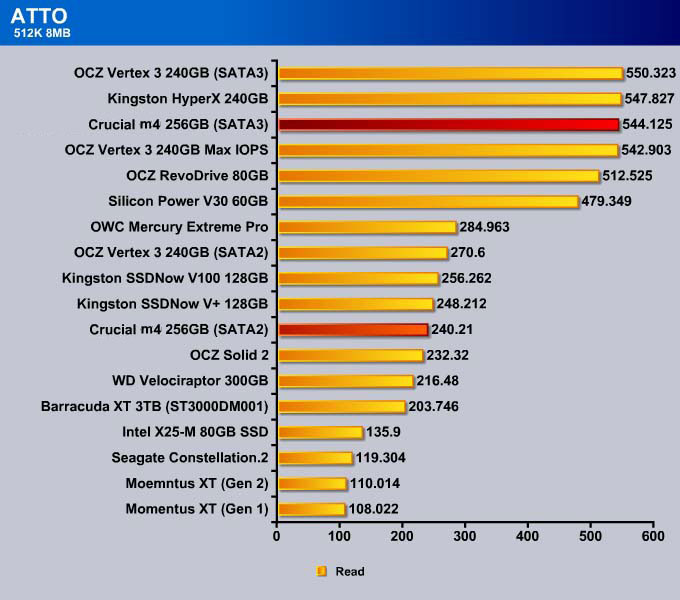

CrystalDisKMark
CrystalDiskMark is designed to test SSDs so it would provide us a better insight in the performance.
4K
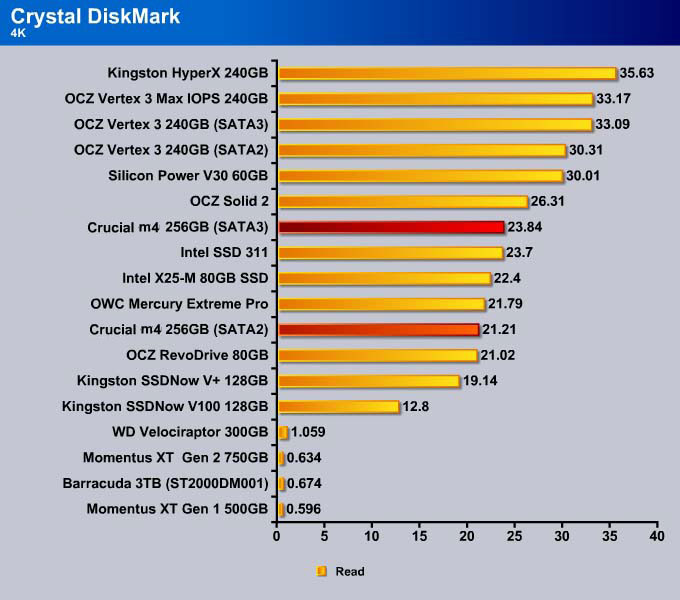

The 4K random write is much better for the Crucial C400. This is an area where Crucial has improved on. Here, the drive is able to edge out the Vertex 3 by 5% and comes just behind the MAX IOPS drive when connected through SATA 6Gbps interface. With SATA 3Gbps interface, however, the Vertex 3 is actually faster by 10%.
While most people will not use more than a few queue depths, we included 32 queue depth to show the drive’s performance under a heavy use environment. The Vertex 3 still comes ahead of the C400 in the read department, however, the difference here has been narrowed slightly. In terms of random write, the m4 falls behind the Vertex 3 under high queue depth.
For desktop usage that often uses a few queue depths, the m4 is certainly fast enough.
512K


However, the write performance has been greatly enhanced by as much as 30% with SATA 6Gbps interface.
Sequential
The improvement on the sequential performance makes the m4’s sequential read faster than the Vertex 3.

However, the sequential write took a bit of beating.
AS SSD Benchmark
4K
AS SSD tests the drive’s ability at handling incompressible data. Unlike SandForce drives that compress data to reduce wearing of NANDs, the m4 does not do real-time compression. The m4 performs quite well here. Clearly, the firmware and the type of NAND on the drive can have a great influence in the performance. The Kingston HyperX, Vertex 3, and Vertex 3 Max IOPS are all based on SandForce SF-2281 yet we see a wide range of the performance difference that ranges from 19.31 to 21.98.
No doubt that the Crucial is the drive of choice for users that write a lot of files such as AVI or MPEG to the drive. The C400 is 46% faster at writing incompressible data over Vertex 3.
4K-64K Thread

Sequential
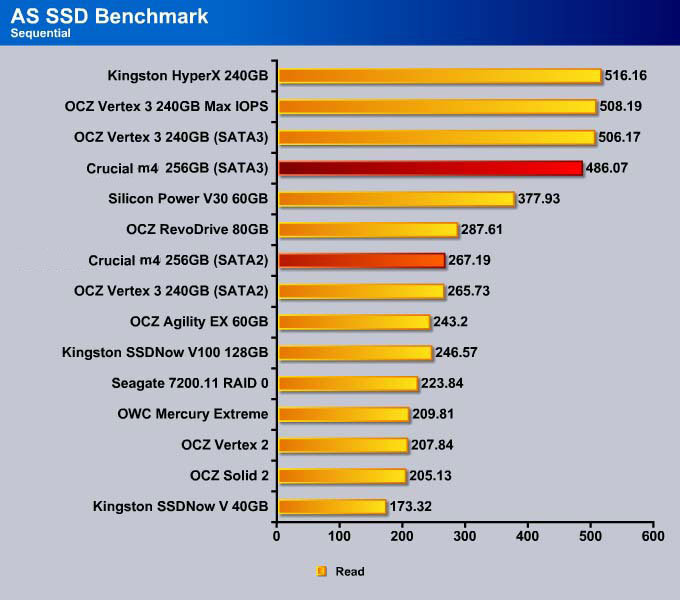

The sequential read and write for the m4 is also slower than the Vertex 3 when comes to handling the incompressible data.
PCMARK 7
While PCMark7 is a synthetic test, it is nonetheless a tool that allows us to assess a drive’s impact on the system performance.
In almost every single test, the PCMark7 HD Suite puts the Crucial drive behind the SandForce drives. There is a bit of good news with the Crucial drive if you look at the chart above. The performance difference between SATA 6Gbps and 3Gbps is only about 5% for the m4, which is much smaller than the SandForce drives. With Vertex 3, we see about a 13% difference.
Clearly, the m4 is much better at handling the incompressible data as shown with the Adding Music to Windows Media Player and the Windows Media Center test.
The Application loading depends heavily on a drive’s random read performance and there’s no surprise here that the C400 takes a backseat behind the other SandForce SF-2000 drives.
Conclusion
The performance of the m4 is rather interesting. The drive’s random write speed is able to compete against SandForce drives but its random read speed falls behind the competitor. Its sequential read is faster and competitive yet the sequential write is noticeable slower than the SandForce drive. It seems like the drive simply cannot find a balance of the read and write performance for a common task. In addition, the drive is also not as fast at higher queue depths than the SandForce drives. However, given the fact that most common desktop tasks are at a low queue depth, we do not feel this is going to be a major issue.
One bit of good news with the m4 drive is that the performance difference between SATA 6Gbps and 3Gbps is not as big as other drives. What this means is that if you are going to use the drive with SATA 3Gbps, you will not experience as big of a performance hit as you would have with the SandForce drives. The SandForce drives simply starve for the extra bandwidth offered.
For average desktop users, the Crucial m4 is definitely not going to slow your system down. While it may not be the fastest drive, it is probably the second to the fastest that you can get. Additionally, since the drive is based on the same controller as the older C300 drive, the firmware should be much more reliable as it has been tested for longer period of time.
Crucial m4 is priced at $40 cheaper than the OCZ Vertex 3 and a whopping $150 cheaper than Intel SSD 510. At this price, the m4 certainly offers a better performance and price ratio than other drives.
| OUR VERDICT: Crucial m4 256GB SSD | ||||||||||||||||||
|
||||||||||||||||||
| Summary: Priced at $40 cheaper than similar performance SSD, the Crucial m4 is one of the better drive in terms of price to performance ratio. The drive should also have reliability issue compare to other SSDs on the market given to its proven firmware. For its quality and features, it earns the Bjorn3D Silver Bear Award. |
 Bjorn3D.com Bjorn3d.com – Satisfying Your Daily Tech Cravings Since 1996
Bjorn3D.com Bjorn3d.com – Satisfying Your Daily Tech Cravings Since 1996








